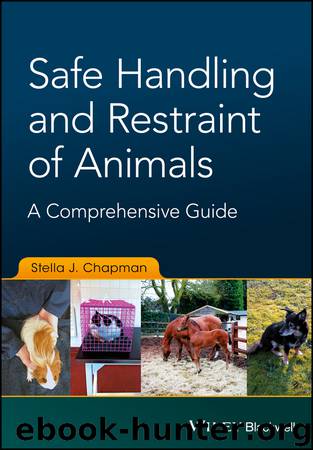Safe Handling and Restraint of Animals by Stella J. Chapman

Author:Stella J. Chapman
Language: eng
Format: epub
Published: 2017-10-06T00:00:00+00:00
9.1 Behaviour
9.1.1 Dairy and Beef Cattle
Cattle are a prey species and will see their handler as a potential threat until they have learnt otherwise. In a threatening situation, cattle's main line of defence is to try and remove themselves. If they cannot do this, then they are likely to rely on their speed, body, head and hooves. This can lead them to pushing the handler against a fence, into other animals or charging through you. Animals that have horns can lead to gorging; nevertheless, even polled animals can cause serious injury. Cattle should be respected for their strength and natural prey behaviour, and must be handled in a considerate and humane manner.
Cattle are naturally very sociable and have a strong herding instinct. Cattle herds have a natural hierarchy with subordinate and dominant individuals, as well as leaders and followers. Cattle that are separated away from other herd members will become increasingly anxious and frightened and thus dangerous.
Cattle have a very keen sense of hearing and vision. The eyes of cattle are on the sides of their head giving them almost 360° vision around their bodies, with a small blind spot directly behind them. Cattle have primarily monocular vision, which limits their ability to judge the size and speed of objects that are approaching. They are only able to judge this in a small area at the front of their nose where their vision becomes binocular. Cattle are dichromate's, meaning that they do not have the ability to see red. They are more likely to see in varying shades of browns and greys.
Cattle are naturally curious as a prey animal, showing interest in new people or objects within their environments. However, novelty can increase the arousal level of cattle and, subsequently, increase the level of excitability or fear. Highly aroused cattle can be difficult to handle and should be given time to settle before any handling is carried out.
The behaviour of beef and dairy cattle will differ due to the different rearing and management systems employed. Fewer problems occur when handling dairy cattle compared to beef, as dairy cattle will have experienced more regular, predictable handling than beef cattle. Beef cattle also rear their young until time of weaning, increasing the protective behaviours displayed by beef cows. In comparison, dairy calves are reared away from mothers in smaller groups with regular contact with humans. Individuals will also vary in temperament. This can differ between and within breeds, and individuals reared together in the same group will differ in temperament. Individual temperaments should be identified during history taking and before any handling commences.
Download
This site does not store any files on its server. We only index and link to content provided by other sites. Please contact the content providers to delete copyright contents if any and email us, we'll remove relevant links or contents immediately.
Craft Beer for the Homebrewer by Michael Agnew(18140)
Marijuana Grower's Handbook by Ed Rosenthal(3619)
Barkskins by Annie Proulx(3300)
Project Animal Farm: An Accidental Journey into the Secret World of Farming and the Truth About Our Food by Sonia Faruqi(3176)
The Plant Messiah by Carlos Magdalena(2881)
Red Famine: Stalin's War on Ukraine by Anne Applebaum(2872)
0041152001443424520 .pdf by Unknown(2783)
Organic Mushroom Farming and Mycoremediation by Tradd Cotter(2626)
In the Woods by Tana French(2530)
Beer is proof God loves us by Charles W. Bamforth(2370)
7-14 Days by Noah Waters(2361)
Reservoir 13 by Jon McGregor(2239)
Borders by unknow(2227)
Meathooked by Marta Zaraska(2220)
The Art of Making Gelato by Morgan Morano(2216)
Birds, Beasts and Relatives by Gerald Durrell(2175)
Between Two Fires by Christopher Buehlman(2163)
The 7 Habits of Highly Effective People: Powerful Lessons in Personal Change (25th Anniversary Edition) by Covey Stephen R(2138)
The Lean Farm Guide to Growing Vegetables: More In-Depth Lean Techniques for Efficient Organic Production by Ben Hartman(2096)
